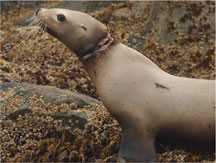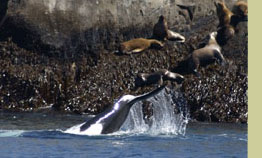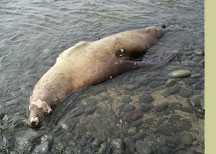What Are We Learning?
 A Complex Puzzle
A Complex Puzzle
Why the Steller sea lion population is not recovering in some areas is a complex puzzle that researchers are working to solve. Possibly many factors are involved: competition with fisheries for their food, low birth rates (maybe as a result of pollution), changing ocean conditions, changing ability of the environment to support animals, mortality from ship strikes, fishing gear entanglement (photo, right), movement out of the area, and high levels of predation from sharks and killer whales.
Detecting Death
Life History Transmitters, LHX tags,
help answer what role predation plays in a unique way. They take body
temperature measurements throughout the life of the animal to determine
how it died. Dr. Jo-Ann Mellish and Dr. Markus Horning captured 45 young
Steller sea lions and implanted them with two LHX tags each from 2005 - 2014.
Through 2020 (so over the course of 15 years), LHX tags allowed them to detect 21 deaths.
 What's Going On? Predation!
What's Going On? Predation!
In at least 13 of the 21 deaths detected, LHX tags sensed a very quick drop from
the normal sea lion body temperature to a much colder, ambient temperature - such as the surrounding
seawater. The tags also sensed light and air right away. From these results
scientists concluded that the tags quickly came out of the sea lion’s
body when a predator dismembered and ate it. The likely cause of death in these 13 juvenile
Steller sea lions was from predation by transient killer whales (photo, left), or maybe sharks.
Transient killer whales regularly eat marine mammals such as sea lions.
(Check out Alaska Crime Scene
Investigations to discover how scientists used the body temperature
to solve this puzzle.) In five more cases, at least one of the two tags
was swallowed by the predator: as before the tags sensed an immediate
temperature drop, but only sensed light and air several days later. Dr.
Horning believes this is because these tags were swallowed by a cold-blooded
predator. The tags only sensed light and air after they were passed or
spit out by the predator. The likely cause of death in these five sea
lions was from attacks by sharks.
Shark Attack!
You can read up on the detailed investigation of how the scientists concluded that very specifically,
the Pacific sleeper is the most likely predator in the case of the five shark attacks detected,
in this freely accessible paper in the journal Fishery Bulletin (donwloadable pdf):
Horning M, Mellish JE (2014) In cold blood: evidence of Pacific sleeper shark (Somniosus pacificus) predation on Steller sea lions (Eumetopias jubatus) in the Gulf of Alaska. Fishery Bulletin 112:297-310.
Three Deaths a Mystery
Even with advanced technology three deaths still remain a mystery. Scientists
only received a small amount of data, which was not enough to determine
a cause of death.
At Least Eighteen out of Twentyone
Deaths Likely from Predators
Researchers conclude that at least 18 of 21 young sea lions that
died were very likely the victims of a predator, 13 from either transient
killer whales or maybe sharks, and five more most likely from sharks.
 Tags Working A-OK
Tags Working A-OK
From tests in ten carcasses (dead sea lion bodies, photo-left)
and from the actual research study, scientists received data from 46 out
of 52 LHX1 tags. From this Dr. Horning concludes that the team can expect
to receive data from 98 out of every 100 animals with dual LHX tags that
die. This successful data recovery rate allows him to do research on fewer
animals to get a scientifically significant result. (See
FAQs).
Surprising Results
Researchers have known for a long time that roughly seven out of ten of young Steller sea lions die before they reach age five. (Our results reflect a similar percentage and support this older data.) However, what is very new and quite surprising is the information on how these animals are dying. “While we have always known that killer whales and sharks ate Steller sea lions, we now have strong evidence that the majority of deaths in juvenile Steller sea lions result from predation,” says Dr. Horning. “This is an exciting new finding that could have significant implications for conservation and management.” It could take until 2020 or later to get information about the cause of death in mature adult Steller sea lions as the study animals age.
How much of a problem is predation for the recovery of the Steller sea lion?
This depends on the number of Steller sea lion deaths compared to the number of births. The second generation of the Life History Transmitter (LHX2) will help researchers find out how many pups female Steller sea lions have over their lifetime. This allow scientists to determine exactly how much of a problem high levels of predation are for the recovery of the Steller sea lion.